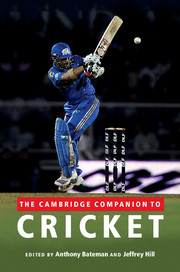Book contents
- Frontmatter
- Introduction
- 1 Cricket pastoral and Englishness
- 2 Cricket in the eighteenth century
- 3 Corruption in cricket
- 4 Broadcasting and cricket in England
- 5 Bodyline, Jardine and masculinity
- 6 Don Bradman: just a boy from Bowral
- 7 The Packer cricket war
- 8 New Zealand cricket and the colonial relationship
- 9 C. L. R. James and cricket
- 10 Reading Brian Lara and the traditions of Caribbean cricket poetry
- 11 The detachment of West Indies cricket from the nationalist scaffold
- 12 The Indian Premier League and world cricket
- 13 Hero, celebrity and icon: Sachin Tendulkar and Indian public culture
- 14 Conflicting loyalties: nationalism and religion in India–Pakistan cricket relations
- 15 Cricket and representations of beauty: Newlands Cricket Ground and the roots of apartheid in South African cricket
- 16 Writing the modern game
- 17 Cricket and international politics
- Further reading
- Index
12 - The Indian Premier League and world cricket
Published online by Cambridge University Press: 28 September 2012
- Frontmatter
- Introduction
- 1 Cricket pastoral and Englishness
- 2 Cricket in the eighteenth century
- 3 Corruption in cricket
- 4 Broadcasting and cricket in England
- 5 Bodyline, Jardine and masculinity
- 6 Don Bradman: just a boy from Bowral
- 7 The Packer cricket war
- 8 New Zealand cricket and the colonial relationship
- 9 C. L. R. James and cricket
- 10 Reading Brian Lara and the traditions of Caribbean cricket poetry
- 11 The detachment of West Indies cricket from the nationalist scaffold
- 12 The Indian Premier League and world cricket
- 13 Hero, celebrity and icon: Sachin Tendulkar and Indian public culture
- 14 Conflicting loyalties: nationalism and religion in India–Pakistan cricket relations
- 15 Cricket and representations of beauty: Newlands Cricket Ground and the roots of apartheid in South African cricket
- 16 Writing the modern game
- 17 Cricket and international politics
- Further reading
- Index
Summary
In the contemporary sporting world, few would doubt that India is the new cricketing superpower. It is more often than not that Indians lead, the others follow. Without exaggeration, Indian cricket is a mirror in which nations, communities, men and women now see themselves. That reflection is sometimes bright, sometimes dark, sometimes distorted, sometimes magnified. Cricket for a billion plus Indians is a source of mass exhilaration and depression, security and insecurity, pride and humiliation, bonding and alienation. In fact, for many in India, cricket has replaced religion as a source of emotional strength and spiritual passion and, since it is among the earliest of memorable childhood experiences, it infiltrates memory, shapes enthusiasms and serves fantasies.
India's position as the new nerve centre of world cricket, completing what I call the ‘decolonisation of Indian cricket’, has been strengthened in recent times thanks to the impact of the IPL on world cricket. The first edition of the IPL, played to packed houses for forty-four days between 18 April and 1 June 2008, was a resounding success by all yardsticks. So much so that there was talk of a withdrawal syndrome among cricket fans once the spectacle was over. In most metropolitan cities across India, as also in many cities across the world with large Indian diasporas, religiously watching IPL action had become a must in April and May 2008.
As the clock struck 8 p.m. Indian time, it was IPL time. It was a passion that was seductively intense and one that cut across age and gender. Spread over forty-four days, the tournament was full of manic moments of drama, spectacle, ecstasy and agony. At the cost of giving favourite soaps and serials a miss, entire Indian families were converted to the heady mix of cricket and entertainment on offer, a package unprecedented and one that transformed the face of Indian and world cricket.
- Type
- Chapter
- Information
- The Cambridge Companion to Cricket , pp. 173 - 186Publisher: Cambridge University PressPrint publication year: 2011
- 13
- Cited by

